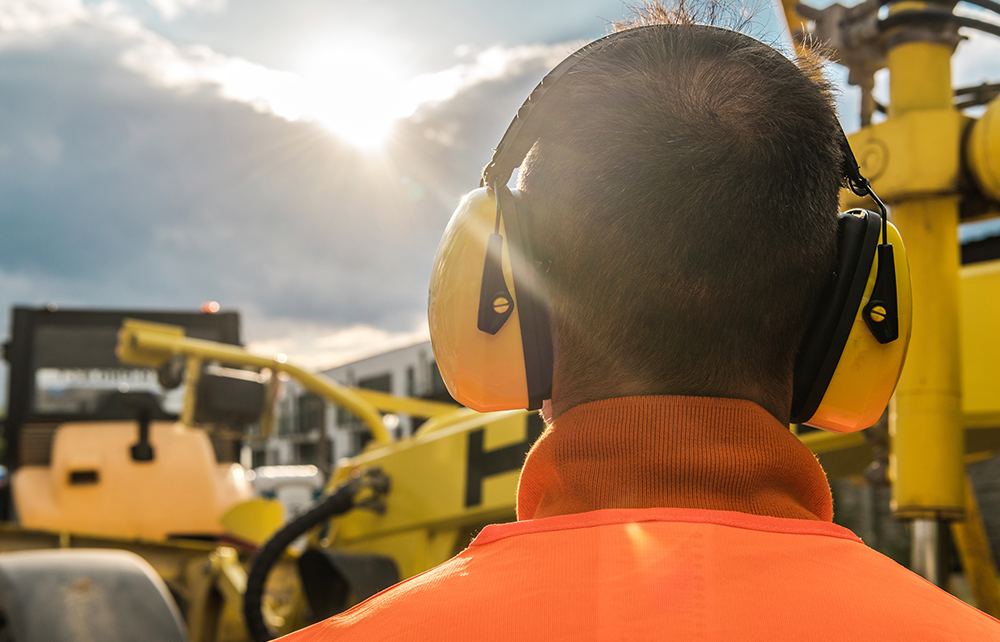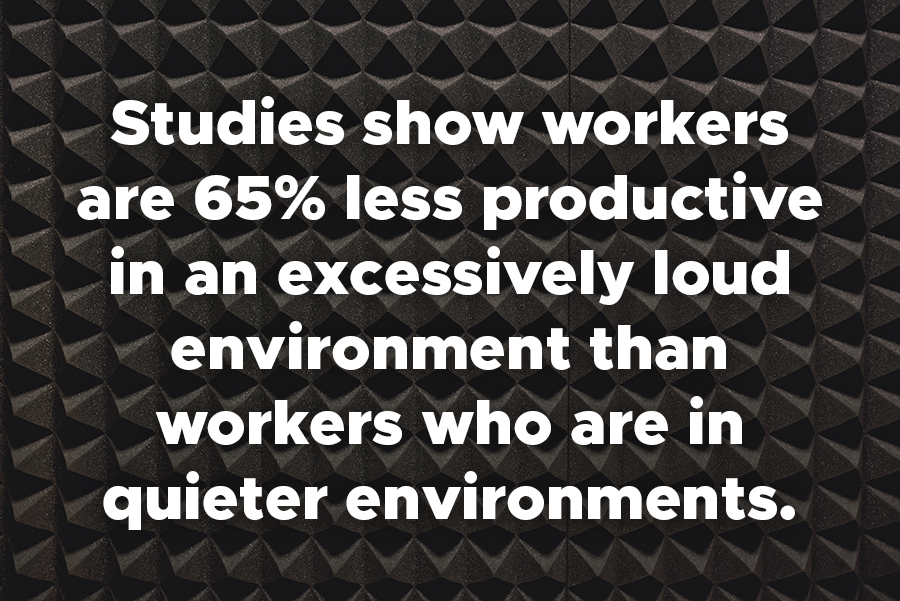
Did you know that noise is one of the most commonly reported occupational health hazards in the U.S.? And what makes it particularly insidious is that it happens so gradually many workers do not notice their hearing is deteriorating until the damage has been done.
According to the National Institute on Deafness and Other Communication Disorders, ongoing exposure to loud noises causes health issues like temporary hearing loss or tinnitus (a constant ringing in the ears). Sometimes, it can even lead to permanent hearing loss.
But how loud is too loud? What can be done to reduce noise in the workplace? This article answers 10 FAQs about the potential dangers of noise hazards your team may face in the workplace. It also offers possible solutions to protect your workers’ hearing.
1. What is Workplace Noise Anyway?
Any unwanted sound can be classified as noise. But when it comes to the workplace, noise is sound that is intense enough to cause a serious safety hazard and can permanently affect workers exposed to it.
Noise is considered hazardous when it reaches 85 decibels or higher or if a person has to raise his/her voice to speak with someone 3 feet away (arm’s length).
The Occupational Safety and Health Administration (OSHA) considers exposure to loud noise both a physical and psychological stressor.
The effects of noise-induced hearing loss can be profound, limiting your ability to hear high-frequency sounds and understand speech and seriously impairing your communication ability.
2. How Serious of a Safety Issue is Noise at U.S. Worksites?
The Centers for Disease Control (CDC) reports that 22 million workers are exposed to potentially damaging noise yearly.
Data from the National Library of Medicine shows that of those 22 million, approximately 33% have audiometric evidence of noise-induced hearing damage, and 16% have a material hearing impairment.
And the scope of the problem doesn’t stop there. Statistics from Occupational Hearing Loss Surveillance (OHL) shows:
- Hearing loss is the third-most common chronic physical condition among adults after hypertension and arthritis
- About 12% of the U.S. working population has hearing difficulty
- About 24% of hearing difficulty among U.S. workers is caused by occupational exposures
- About 8% of the U.S. working population has tinnitus, and 4% have both hearing difficulty and tinnitus
3. What Noise Level is Considered Hazardous?
Sound is measured in decibels (dB). A whisper is about 30 dB, normal conversation is about 60 dB, and a motorcycle engine running is about 95 dB. Noise above 70 dB over a prolonged period may start to damage your hearing. Loud noise above 120 dB can cause immediate harm to your ears.
The table below shows data gathered from the CDC, which lists some standard items and their dB levels.
Some Typical Noise Hazard Decibel Levels or “dB(A)s”
Ticking watch | 10 dB(A) |
Air conditioner | 60 dB(A) |
Gas-powered lawnmower | 80-85 dB(A) |
Industrial vacuum | 85 dB(A) |
Electric drills | 102 dB(A) |
Air hammer on metal | 112 dB(A) |
Sirens in close proximity | 120 dB(A) |
Firecrackers | 140-150 dB(A) |
4. Does Noise Affect Productivity?
A study published in the British Journal of Psychology asked workers to perform two tasks, first tested without noise and then with a recording of general noise. The test with noise showed a decrease in the accuracy of their work by almost 67%. It also showed that workers were 65% less productive in the excessively loud environment.

In addition, it was proven that noise also contributes to workplace accidents and injuries by making it difficult to hear warning signals.
5. What are Some Examples of Noise Hazards in the Workplace?
Workers may be at risk of hearing troubles if they are exposed to things like:
- Heavy machinery often used in occupations like agriculture, construction, industrial manufacturing, and many processing plants is almost always loud
- Impact tools such as air guns, riveters, and air wrenches are good examples of heavy impact tools that can cause severe workplace hearing loss over time
- Loud ambient noise found in most factory settings is caused by the many machines that constantly run and pack quite a punch to a worker’s hearing
- High-power tools create a constant, loud “buzz” as they draw energy and also put off their own noise hazard when in use
- Work vehicles like ground vehicles, planes, and even ships create hazardous noise levels when just operating under normal conditions
6. How do Hazardous Noise Levels Result in Hearing Loss?
Hearing is a complicated process that involves many fragile ear parts working together to relay signals to the brain. One of the first working parts to process noise is nerve endings in our inner ear.
Exposure to loud noise kills those nerve endings. More exposure will result in more dead nerve endings. Hearing aids may help, but they do not restore your hearing to normal.
Sometimes, the result of long-term noise exposure is permanent hearing loss that cannot be corrected through surgery or medicine.
This video from the National Institute of Health (NIH) shows how the ear works and the “Journey of Sound to the Brain.”
7. What are Acceptable Noise Levels in the Workplace?
According to the National Institute for Occupational Safety and Health (NIOSH), workplace noise exposure “should be controlled below a level equivalent to 85 dBA for eight hours to minimize occupational noise-induced hearing loss.”
A good rule of thumb for knowing when your environment may be too loud is how loud you must speak to be heard. If you need to raise your voice to talk to someone 3 feet away, noise levels might be over 85 decibels.
Noise may be a problem in your workplace if you:
- Hear ringing or humming in your ears when you leave work
- Have to shout to be heard by a coworker an arm’s length away
- Experience temporary hearing loss when leaving work
The NIOSH-provided table below specifies the maximum allowable daily noise dose for varying exposure levels.
Average Sound Exposure Levels to Reach the Max Allowable Daily Dose of 100%
| Time to reach 100% noise dose | Exposure level per NIOSH REL |
| 8 hours | 85 dB(A) |
| 4 hours | 88 dB(A) |
| 2 hours | 91 dB(A) |
| 60 minutes | 94 dB(A) |
| 30 minutes | 97 dB(A) |
| 15 minutes | 100 dB(A) |
8. How is Noise Measured in the Workplace?
Several sound-measuring instruments are available to measure the noise levels in a workspace. These include sound level meters, noise dosimeters, and octave band analyzers.
NIOSH offers a Sound Level Meter App as one tool available to the public. It can be downloaded on mobile iOS devices. It measures workplace sound levels and provides exposure parameters to help reduce occupational noise-induced hearing loss.
More details can be found on the NIOSH Science Blog — Understanding Noise Exposure Limits: Occupational vs. General Environmental Noise.
9. How Can You Reduce Noise Hazards in the Workplace?
OSHA requires employers to implement a hearing-conservation program “whenever worker noise exposure is equal to or greater than 85 dBA for an 8-hour exposure or in the construction industry when exposures exceed 90 dBA for an 8-hour exposure.”
Some ways to control or protect against occupational noise hazards involve:
- Engineering controls, which include modifying or replacing equipment, substituting less-noisy alternatives, separating the noise source from workers, or conducting noise-reducing maintenance or repairs
- Administrative controls, including limiting the duration of exposure to noisy equipment, providing quiet spaces for respite away from noise, and running noisy machines during less-populated shifts
- Hearing protection devices are the last line of defense but still one that remains critical in the overall hearing conservation strategy
The NIOSH Buy Quiet program provides information on equipment noise levels, so companies can buy quieter products that make the workplace safer.
10. What is the Suggested PPE for Noise Hazard Protection?
According to OSHA regulations, effective and properly worn hearing protection must be worn every time a worker is exposed to hazardous noise levels.
The regulation requires that “employers shall make hearing protectors available to all employees exposed to an 8-hour time-weighted average of 85 decibels or greater at no cost to the employees.”
However, over half of noise-exposed workers do not use hearing protection when exposed to noise on the job. And that is unfortunate. When used correctly, hearing PPE has been shown to significantly reduce exposure to hazardous noise levels and can lower the risk of hearing damage.
To reduce intense noise exposure, PPE that workers widely use includes the following:
Earplugs, which are inserted in the ear canal and may be pre-molded, moldable, roll-down foam, push-to-fit, or custom molded. Disposable, reusable, and custom earplugs are available.
Banded earplugs consist of two earplugs held over the ends of the ear canal by a rigid headband.
Earmuffs consist of sound-attenuating material, soft ear cushions that fit around the ear, and hard outer cups. They are held together by a headband.
Each device has advantages and disadvantages. All are great to include in your hearing protection arsenal because each offers a unique benefit.
Liberty Safety Can Help
There are many factors to consider when selecting which PPE product is right for your workers, which is why Liberty Safety offers varying hearing protection devices (HPDs).
However, the best HPD is one that a worker will wear. Those using hearing protection should follow the CDC’s 4 C’s:
- Clean – plugs and hands for insertion
- Consistent – for levels 85 dB(A) and above
- Correct – insertion method
- Comfortable – for the user, offer choices
This information applies to the workplace and is also relevant for protecting hearing wherever noise levels are loud.
Do you have more questions about hearing protection? The customer service team at Liberty Safety is here to help. Head over to our website and check out our selection of hearing PPE today. You and your workers’ ears are counting on it!

